Top 12 Loader Skills to Put on Your Resume
In a crowded job market, a sharp resume helps loaders rise above the pile. Put your strongest skills upfront. Make it obvious you know how to move freight safely, keep counts tight, and keep the flow humming from dock to door.
Loader Skills
- Forklift Operation
- Pallet Jack
- Inventory Management
- RF Scanners
- Warehouse Management Systems (WMS)
- OSHA Safety Standards
- Hazardous Materials Handling
- Shipping & Receiving
- Order Picking
- Container Loading
- Supply Chain Logistics
- Quality Control Procedures
1. Forklift Operation
Forklift operation means running a powered industrial truck to lift, carry, and place materials over short distances inside warehouses, yards, or job sites.
Why It's Important
It enables fast, accurate, and safer movement of goods. That boosts productivity while cutting damage and injury risk.
How to Improve Forklift Operation Skills
Get trained and certified: Complete formal instruction and hands-on evaluation, then refresh regularly and whenever conditions change.
Master safety checks: Do pre-shift inspections, verify forks, hydraulics, tires, horn, lights, and brakes. Don’t operate questionable equipment.
Load handling: Keep loads low and tilted back, respect capacity plates, center the weight, and avoid sudden turns or ramps with a raised load.
Situational awareness: Drive at walking speed in tight areas, sound horns at blind corners, maintain clear sightlines, and use spotters when visibility drops.
Maintenance and telematics: Report faults early, follow service schedules, and use monitoring tools to track impacts, speed, and utilization.
How to Display Forklift Operation Skills on Your Resume
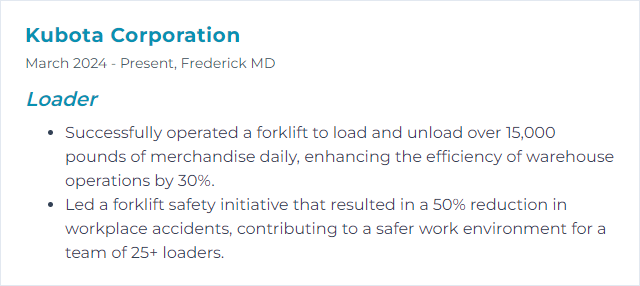
2. Pallet Jack
A pallet jack (manual or powered) lifts and moves palletized loads across short stretches of floor space.
Why It's Important
It reduces strain, speeds movement of heavy goods, and lowers injury risk when used correctly.
How to Improve Pallet Jack Skills
Pre-use checks: Inspect wheels, forks, handle, and hydraulics. Confirm brakes and deadman features on powered units.
Ergonomic handling: Push rather than pull when possible, keep elbows close, and take shorter routes with fewer turns.
Load discipline: Match capacity, center weight, stabilize shrink-wrap, and keep the path clear before moving.
Surface and wheels: Use the right wheels for your floor and environment; swap worn casters early for smooth tracking.
Grade and dock safety: Keep loads upgrade on ramps, slow down near edges, and chock where needed.
How to Display Pallet Jack Skills on Your Resume

3. Inventory Management
Inventory management for loaders means knowing what’s on hand, where it sits, and how it moves—keeping counts accurate and locations dependable so orders flow without snarls.
Why It's Important
It prevents stockouts and overstock, trims carrying costs, and keeps staging and shipping on schedule.
How to Improve Inventory Management Skills
Use a system: Track receipts, moves, picks, and adjustments with barcode or RFID. Real-time updates beat guesswork.
Cycle count routinely: Small, frequent counts catch errors early. Investigate root causes, not just symptoms.
Forecast and reorder: Base reorder points on demand, lead time, and safety stock. Review seasonality and promotions.
Slotting and ABC: Place fast movers close to docks, group families together, and focus control on high-value A items.
Standardize labeling: Clean, scannable labels and consistent location names reduce mis-picks and wandering.
Train and measure: Teach receiving-to-shipping flows, then track accuracy, fill rate, and days on hand.
How to Display Inventory Management Skills on Your Resume
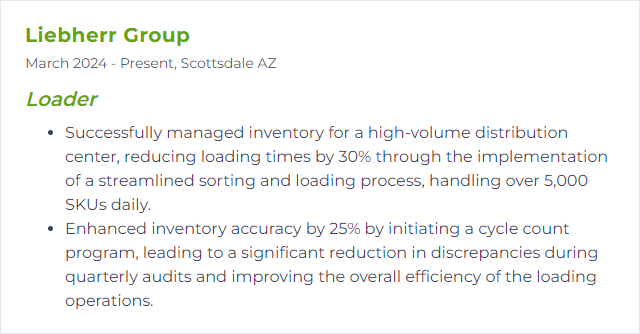
4. RF Scanners
RF scanners are handheld devices that capture barcodes and send data wirelessly, updating inventory and orders in real time.
Why It's Important
They slash manual entry errors, confirm the right item at the right time, and keep the system synced to what’s really happening on the floor.
How to Improve RF Scanners Skills
Rugged readiness: Use devices rated for drops, dust, and moisture. Protect screens and ports; keep spares charged.
Fast, clean scans: Learn optimal distance and angle. Keep labels clean and replace damaged ones promptly.
Smart software: Enable offline caching, simple prompts, big buttons, and error tones or haptics for gloved hands.
Battery discipline: Hot-swap batteries, rotate chargers, and set charging habits to cover peak shifts.
Network coverage: Map dead zones, boost access points, and test roaming so scans don’t stall.
How to Display RF Scanners Skills on Your Resume

5. Warehouse Management Systems (WMS)
A WMS is software that directs warehouse work—receiving, putaway, picking, packing, and shipping—so people and inventory move with purpose.
Why It's Important
It reduces manual errors, assigns tasks efficiently, and keeps orders flowing with traceability from dock to delivery.
How to Improve Warehouse Management Systems (WMS) Skills
Follow directed workflows: Use system prompts for putaway, replenishment, and picking rather than memorized shortcuts.
Real-time discipline: Scan every move when it happens. Late updates create snarls downstream.
Optimize locations: Use WMS slotting tools and heat maps to place fast movers near docks and minimize travel.
Go mobile: Run WMS on handhelds or vehicle mounts to cut paper, reduce delays, and keep data live.
Keep it current: Apply updates, clean master data, and retire obsolete locations and SKUs.
Track metrics: Monitor pick rate, dock-to-stock time, inventory accuracy, and right-first-time shipments.
How to Display Warehouse Management Systems (WMS) Skills on Your Resume
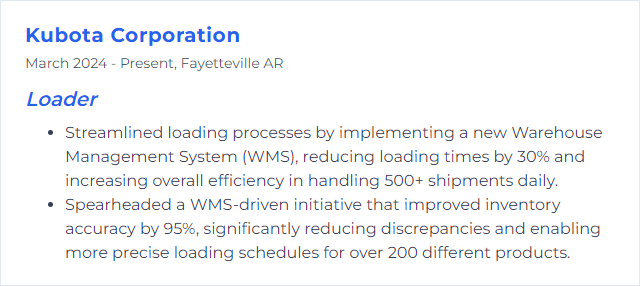
6. OSHA Safety Standards
OSHA sets rules that protect workers around powered trucks, docks, chemicals, and more. Loaders live in that world daily.
Why It's Important
Following OSHA standards cuts injuries and downtime. It’s about going home with all fingers and toes, every shift.
How to Improve OSHA Safety Standards Skills
Targeted training: Cover forklifts, pedestrian safety, hazard communication, PPE, and emergency actions with hands-on practice.
Inspections and audits: Use checklists, correct hazards quickly, and verify fixes actually stick.
Near-miss culture: Encourage reporting without blame. Investigate and share lessons in toolbox talks.
LOTO and equipment care: Lock out unsafe gear, tag it, and keep maintenance schedules tight.
Ergonomics: Teach safe lifting, rotation of tasks, and use of aids to prevent strains.
How to Display OSHA Safety Standards Skills on Your Resume

7. Hazardous Materials Handling
Hazardous materials handling means recognizing, segregating, loading, securing, and documenting dangerous goods per regulations—without spills, reactions, or exposure.
Why It's Important
It protects people and the environment, keeps you compliant, and avoids costly incidents and shutdowns.
How to Improve Hazardous Materials Handling Skills
Know the hazards: Read current Safety Data Sheets (SDS), labeling, and class/division rules before touching product.
PPE that matches risk: Select gloves, eye/face, and respiratory protection as required by the substance and task.
Segregation and compatibility: Keep incompatibles apart, use proper placards, and secure loads against shifts.
Spill readiness: Stage kits, neutralizers, and absorbents. Drill on immediate containment and notification steps.
Inspect and document: Check packaging integrity, verify marking, labeling, and paperwork before release.
How to Display Hazardous Materials Handling Skills on Your Resume

8. Shipping & Receiving
Shipping loads outbound, receiving brings them in. Loaders turn paperwork into pallets on the right truck or racks in the right bay.
Why It's Important
Accurate, on-time moves keep promises to customers and keep inventory honest. Misses snowball fast.
How to Improve Shipping & Receiving Skills
Standard work: Clear steps for staging, scanning, sealing, and documentation—no guesswork.
Dock scheduling and flow: Time slots, staging lanes, and visible priorities reduce congestion and dwell.
Verification: Scan to confirm item, quantity, lot/serial, and stop labels. Photo-documented damage on arrival.
Equipment readiness: Maintain dock plates, restraints, lights, and yard checks. Bad gear causes delays and injuries.
Feedback loop: Capture load exceptions and driver notes; refine processes where errors cluster.
How to Display Shipping & Receiving Skills on Your Resume

9. Order Picking
Order picking is selecting the right items, from the right locations, in the right quantities—prepped and ready to ship.
Why It's Important
Mispicks cost time and trust. Clean picks move orders out fast and right.
How to Improve Order Picking Skills
Smart slotting: Place high-volume SKUs close, heavy low, fragile safe, and relate items together.
Pick methods: Use batch, zone, or wave picking depending on order mix and layout.
Tech assist: Scan every pick; consider voice or light guidance for speed and confirmation.
Quality checks: Use check digits, countbacks, or a final audit for high-risk items.
Ergonomics and 5S: Clear aisles, good lighting, reachable picks—less strain, fewer errors.
How to Display Order Picking Skills on Your Resume
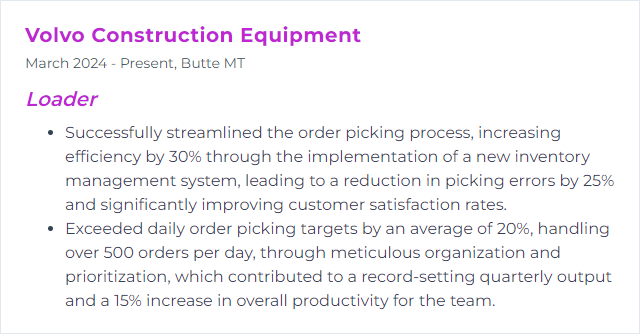
10. Container Loading
Container loading is the art and math of arranging cargo inside a box so it rides safely, fits tightly, and respects limits.
Why It's Important
Good loading prevents damage, uses space efficiently, and keeps shipments legal and on time.
How to Improve Container Loading Skills
Plan the load: Build a load plan with dimensions, weights, and sequence before the first pallet moves.
Weight distribution: Place heavy items low and centered, balance front-to-back and side-to-side, and honor axle and gross limits.
Block and brace: Use dunnage, straps, load bars, and airbags to stop shifts. Fill gaps thoughtfully.
Protect the product: Shield edges, stabilize stacks, and consider moisture control where needed.
Compliance: Follow container packing guidelines and verify gross mass before dispatch.
How to Display Container Loading Skills on Your Resume

11. Supply Chain Logistics
Supply chain logistics orchestrates the movement and storage of goods from origin to destination. Loaders are the hands that make that plan real.
Why It's Important
Efficient loading trims transit times and costs, reduces claims, and helps orders arrive complete and intact.
How to Improve Supply Chain Logistics Skills
Reduce touches: Cross-dock when possible, combine moves, and keep travel paths short.
Visibility: Use real-time scanning, ASN data, and clear staging to see what’s next and what’s late.
Route and dock alignment: Stage by route, stop, and temperature or hazard class to speed departures.
Packaging and unitization: Solid pallets, right wrap, corner boards, and correct labels prevent rework.
Continuous training: Refresh on new procedures and equipment; rotate roles to build flexibility.
How to Display Supply Chain Logistics Skills on Your Resume
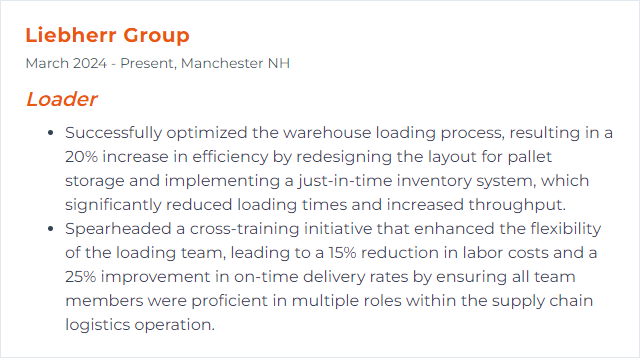
12. Quality Control Procedures
Quality control for loaders means checks that ensure equipment is safe, products leave undamaged, and counts are right the first time.
Why It's Important
QC stops defects at the source—fewer claims, fewer returns, fewer headaches.
How to Improve Quality Control Procedures Skills
Standardize: Write clear steps and acceptance criteria for receiving, picking, packing, and loading.
Checklists: Pre-load and post-load inspections catch loose wrap, leaning stacks, and labeling misses.
First-piece verification: Confirm the first pallet or order before running the rest.
Calibrate: Maintain scales, scanners, and measuring tools so the numbers you trust are true.
Layered audits: Supervisors and peers spot-check work; record defects and fixes.
CAPA mindset: Correct the problem now, prevent it next time with root-cause action.
How to Display Quality Control Procedures Skills on Your Resume

